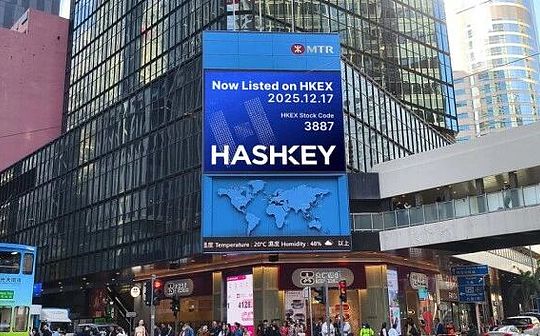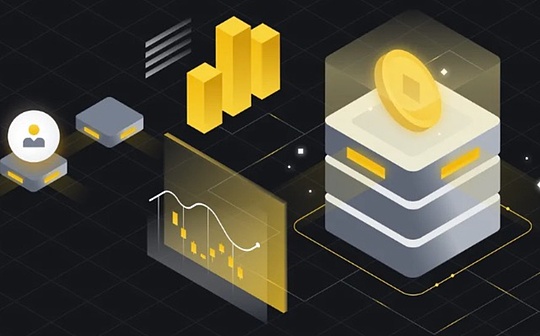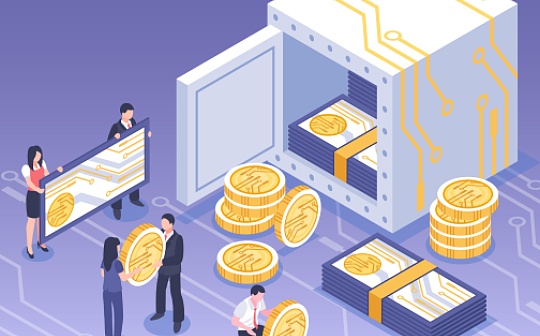
Author: Ken Alabi, CoinTelegraph; Compiled by: Tao Zhu, Bitchain Vision
Every four years, a few months after Bitcoin halving, the blockchain ecosystem is closely watched by the public.This period usually lasts for more than one year and is driven by basic economic principles: its value usually rises when the supply of assets decreases and demand remains stable or increasing.Historically, this supply shock has triggered a Bitcoin-dominated market appreciation, triggering increased interest and participation among users, developers, investors, and policy makers.
During these periods after the halving, the blockchain industry demonstrates its projects, technological innovations and potential utility.None of the previous cycles produced a blockchain application that clearly surpassed the prior art in any particular field.However, the core advantages of blockchain—the immutability, data transparency and user asset sovereignty enabled by private key encryption—continue to attract innovators.These features have been creatively applied in a wide range of areas including borderless payment systems, DeFi, NFT, gaming systems with in-game assets, fan and loyalty tokens, transparent grants and charity spending systems, agricultural subsidies and loanstrack.
While past cycles highlight the potential of blockchain, new use cases are expected to be piloted in the next period, as described below.
Lessons from the past halving cycle
The period after the halving in 2012 highlighted the potential of an intermediary-free and borderless payment system.Before Bitcoin, intermediary payments and slow cross-border transactions were the norm—international transfers would take several days, and check customs clearance was equally slow.Bitcoin hints at the future of seamless payments, with early adopters tracking the number of businesses that accept Bitcoin.However, scalability issues and rising transaction costs limit this utility.Ironically, many blockchain networks have prevented their success through a fee structure that hinders growth.The cycle ended with a security breach, especially the Mt. Gox hack that occurred 20 months after halving.
The 2016 cycle triggered an explosion of initial token offerings (ICOs), democratizing access to venture capital.Ordinary individuals can now invest in early stage projects—an opportunity once reserved only for large financial institutions.However, the market is filled with tokens that are only supported by white papers.The lack of investor protection and accountability has led to a rapid collapse of many ICOs.Most projects of that era were outdated, and even the largest ICOs were no longer among the top 100 blockchain projects.
In 2020, three major trends dominated: DeFi Program, NFT and Play-Watch (P2E) games.DeFi projects promise unsustainable benefits—sometimes over 100%—to provide benefits by minting more tokens without any economic activity.Similarly, NFTs have high valuations, some of which are just pixel art and cannot preserve their value.As expectations of massive virtual adoption fail to come true, the hype of the metaverse has faded.The P2E game relies on inflation token economics, and when growth stagnates, it collapses, exposing the vulnerability of these models.
The post-halving cycle in 2024 begins with the approval of the US Bitcoin ETF, officially integrating cryptocurrencies into traditional financial markets.This move, coupled with the increasingly influenced democratic processes by the blockchain community, marks a major shift.
This is the first time that crypto assets are inside and not outside the financial system, which has the potential to lead to balanced regulation rather than a full hostility to the technology.People see its practicality in nature and discuss it.The U.S. is ready to play a leading role in adopting blockchain technology, which bodes well, especially given the role the U.S. plays in other previous technological innovations and advancements.The next question is: How far will this integration go?Will we see more countries adding crypto assets to their national reserves, not just one or two countries that already have crypto assets?In addition to regulatory progress, several blockchain applications are expected to be reviewed this cycle.
Tokenizing and diversifying real-world assets has gained attention.RWA enables asset owners to benefit directly from blockchain-based financing.Key areas include real estate and housing financing, stocks, bonds, treasury bills, agricultural financing, DePIN and DePUT.
Blockchain-AI synergy
AI and blockchain are becoming a powerful force.The decentralized management of AI models and secure data processing provide new solutions, especially in terms of privacy.AI can go beyond ZK-SNARK by managing encrypted data, only disclosure of data or data proof to its owner (as per the direction of its owner), or under certain conditions to an authorized law enforcement agency (depending on the composition of the blockchain)etc.
Microtransactions
Due to high operating costs, traditional financial systems cannot support microtransactions.With the low-cost transaction model, blockchain is naturally suitable for micro payments, especially content consumption.This could eliminate outdated bundling practices in the media and drive a new era of seamless payments.
Memecoins and Celebrity Tokens
Memecoins has surged, with nearly 10 of the top 100 tokens currently in market cap, but hardly any practical utility.Low-cost blockchain and user-friendly token creation tools fuel this trend.Meme tokens launched by or around well-known public figures are also becoming more and more popular, but most are equally lacking in practicality.
Stable Coin
Stablecoins continue to connect traditional finance and blockchain.With faster and cheaper blockchains dominating this cycle, stablecoins are being widely used for payments, challenging traditional systems such as slow check settlements and expensive cross-border transfers.Regulatory clarity may drive stablecoins to mainstream adoption.
What did the early data reveal
Toronet Research tracks the performance of various tokens from January to May 2024, predicting the December trend.Research results:
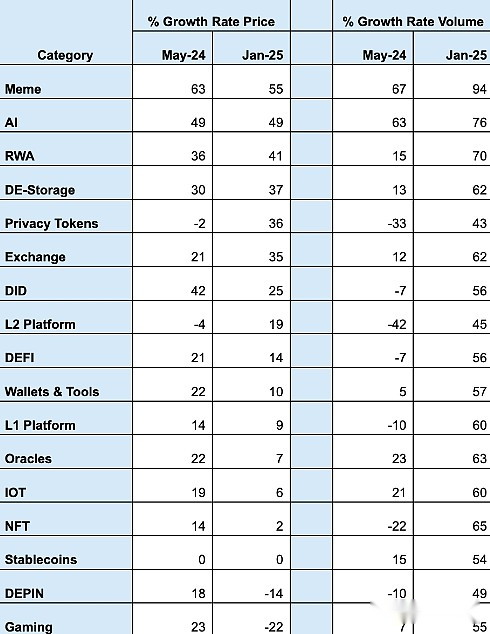
Data are sorted by price growth rate for January 2025.Source: Toronet Research, January 2025.
Data shows thatmemecoin, AI-related tokens and RWA tokens are the leaders in early growth.Other observations include that transaction volume growth has occurred in all categories, which is common in periods where interest and engagement in blockchain projects seem to increase every four years.DePIN projects may not experience much growth at the beginning of the cycle, although some breakthroughs may be made by one or more innovative projects.The growth of the Tier 2 project exceeds the growth of the Tier 1 project, or absorbs most of the growth that the latter will experience.The January 2025 results are presented in chart form as follows.
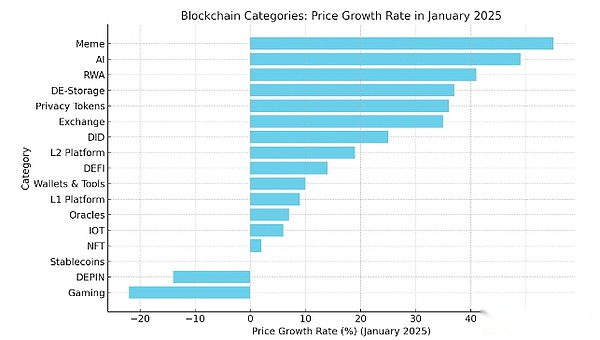
Price growth trend bar chart for January 2025.Source: Toronet Research.
CoinGecko’s Q3 2024 Crypto Industry Report reviews popular categories by network traffic, with findings similar to those found in the top three categories.Another observation reported by Toronet Research is that, as we have seen in the past cycle,In the application areas where the previous cycle caused the fanaticism was not very practical,For example, the ICO in 2017 and the NFT in 2021,It is often denied in the next cycle.Developers and industry leaders should work to guide new adopters towards sustainable, practical-driven projects to reduce market volatility and minimize investor disillusionment.This will reduce the intensity of the four-year boom cycle and the extent and number of disillusioners, many already lined up to chase memecoin and eventually turned worthless airdrops into futility.
Will we break this cycle?
The current cycle provides blockchain with the most important opportunity to have lasting impact so far.With the increasing institutional integration, more thoughtful regulatory commitments and a shift to real-world utility, the industry is expected to achieve meaningful growth.The increasing acceptance and integration of blockchain solutions in the wider economy, as well as the potential of upcoming thoughtful regulatory regulations, may lead to better results in this cycle than ever.




